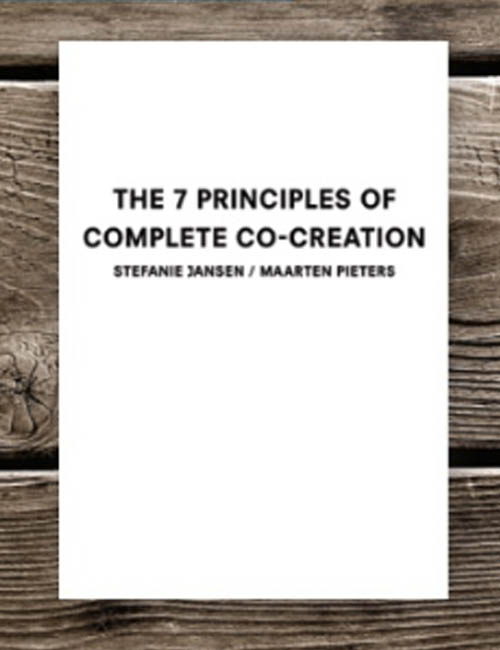Reviewed by Caryn Goldsmith, caryn@goldsmithstrategicservices.com
Goldsmith Strategic Services, Los Angeles, CA
The term co-creation is suddenly everywhere, even though co-creation has been a long-used marketing/marketing research tool. In The 7 Principles of Complete Co-Creation, Stefanie Jansen and Maarten Pieters provide an in-depth exploration of what they term “complete co-creation.” The book is well written, and chock full of co-creation case studies and examples.
It provides a detailed rationale of why “complete co-creation” is needed, coupled with how-tos that offer step-by-step guidance for employing it. The primary target appears to be client-side organizations. While qualitative researchers who employ co-creation techniques may not be in need of an entire book to convince them that co-creation is important, the book provides some interesting nuggets that could elevate their practice.
As a former agency account planner and current qualitative research consultant, I feel the idea of the consumer/end user being a key player in all stages of development (product, service, customer experience, branding communication, etc.) is a given. But in reality, there are organizations that don’t value marketing research or direct consumer input. This book makes the argument for why those organizations will be increasingly left behind in a world where end users expect to be actively engaged with brands.
To start, Jansen and Pieters argue that consumers/end users should be present in all stages of a set assignment. Simple enough idea, but they go beyond this and argue that we can connect with customers and derive customer insights from those interactions with the ultimate goal to co-create products, services, customer experiences and marketing programs. In addition, they argue that co-creation with end users will require client organizations to restructure themselves to support those new offerings, reflecting a co-ownership of ideas. This translates into a compact between a company and its end users, which in turn leads to increased user loyalty and engagement.
The tables/graphics in each chapter are terrific thought-starters. One table detailing when “complete co-creation” will work and when it won’t got me thinking about the clients I’m serving and why some of them are more open to innovation while others are not.
Central to the idea of “complete co-creation” is the fact that the organization must have a capable co-creator on staff or be willing to bring one in from the outside. More than that, and a main tenet of the book, is that culturally an organization must be ready to cede some of its power to end users in order for any of these endeavors to work. In my view, internal silos (a common organizational structure) can’t be posturing for power while end users are talking and no one is listening.
So, on the premise that some end-user involvement is better than no involvement, there are many ideas in the book that might be used to heighten the current level of end-user engagement. For instance, many clients have advisory councils, often made up of key target consumers (especially in B2B). As I was reading, I got the idea I should meet potential council members in their homes/offices for an on-site contextual visit before they are asked to join a council. I feel as though I’d be a much better council facilitator if I could anchor feedback in this way. Not a central idea of “complete co-creation” but a spark of an idea I can use.
I also loved the authors’ “five Fs to complete co-creation”: Founding, Finding, Forming, Fine-tuning, and Following-up. A great refresher, the authors highlight what’s involved in each step and what cues the go/no-go decisions. I can envision pulling out this graphic and sharing it with a client, saying, “We’re here and to get there, our next step is this…”
In addition to pulling this book off my shelf to look for an example or case history to use with a client when the need arises, I can also see gifting this book to a client who is working in a culture that needs to involve end users more consistently in their development processes but doesn’t know how. It may help them to evolve their organization.
In short, this book offers a useful perspective on how to partner with consumers/end users for optimal marketplace success.


Be the first to comment